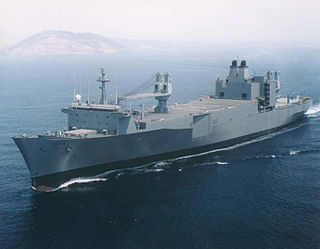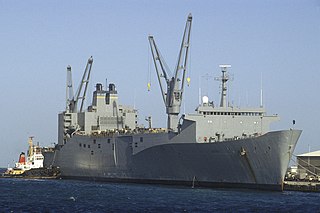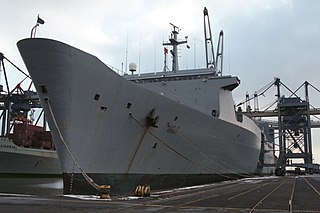
Strategic sealift ships are part of the United States Military Sealift Command's (MSC) prepositioning program. There are currently 17 ships in the program, strategically positioned around the world to support the Army, Navy, Air Force, Marine Corps and Defense Logistics Agency. Most are named after Medal of Honor recipients from the service they support. The ships are assigned to two Military Prepositioning Ship (MPS) squadrons located in the Indian Ocean at Diego Garcia and in the Western Pacific Ocean at Guam and Saipan.

Military Sealift Command (MSC) is an organization that controls the replenishment and military transport ships of the United States Navy. Military Sealift Command has the responsibility for providing sealift and ocean transportation for all US military services as well as for other government agencies. It first came into existence on 9 July 1949 when the Military Sea Transportation Service (MSTS) became solely responsible for the Department of Defense's ocean transport needs. The MSTS was renamed the Military Sealift Command in 1970.

The Algol-class vehicle cargo ships, also known as Fast Sealift Ships (FSS) or SL-7s, are currently the fastest cargo ships in the world, capable of speeds in excess of 33 knots (61 km/h). Originally built in 1972 and 1973 as high-speed container ships known as SL-7's for Sea-Land Services, Inc., the ships' high operating costs limited their profitability. All eight ships were acquired by the US Navy in 1981 and 1982, with the last ship converted, delivered to and placed in service with Military Sealift Command in 1986. The conversion entailed the installation of four cranes, addition of roll on/roll off capability and a redesign of the cargo hold to better facilitate storage of vehicles. Due largely to their high cost of operation, all fast sealift ships are kept in Reduced Operating Status, but can be activated and ready to sail in 96 hours. All ships are named after bright stars in the night sky.

SS Shughart (T-AKR-295) is the lead ship of her class of cargo ships operated by the United States Navy. She is a 'roll-on roll-off' non-combat vessel designated as a "Large, Medium-Speed Roll-on/Roll-off" (LMSR) ship.

USNS Comet (T-AK-269), later T-LSV-7, later T-AKR-7, later SS Comet, is a vehicle landing ship built for the United States Navy. The lone ship of her class, she is named for the comet, and is the fourth U.S. Naval vessel to bear the name.

USNS Sea Lift (T-LSV-9) was a roll on/roll off (Ro/Ro) cargo ship built for the United States Navy's Military Sea Transportation Service (MSTS), currently the Military Sealift Command (MSC). She became the first ship of Ro/Ro-type to deliver cargo to Vietnam during the war in Indochina.

SS Algol is an Algol-class vehicle cargo ship that is currently maintained by the United States Maritime Administration as part of the Military Sealift Command's Ready Reserve Force. She was built as a high speed container ship by Rotterdamsche Droogdok Maatschappij N.V. in Rotterdam, the Netherlands, hull no. 331, for Sea-Land Service, Inc. and named SS Sea-Land Exchange, USCG ON 546383, IMO 7303205. Due to her high operating cost, Sea-Land Exchange was sold to the United States Navy in October 1981 as USNS Algol (T-AK-287).

SS Bellatrix is an Algol-class vehicle cargo ship that is currently maintained by the United States Maritime Administration as part of the Military Sealift Command's Ready Reserve Force (RRF). She was built as a high-speed container ship by Rheinstahl Nordseewerke, Emden, West Germany, hull no. 430, for Sea-Land Service, Inc. and named SS Sea-Land Trade, USCG ON 545201, IMO 7236153. Due to her high operating cost, Sea-Land Trade was sold to the United States Navy in October 1981 as USNS Bellatrix (T-AK-288).

SS Denebola is an Algol-class vehicle cargo ship that is currently maintained by the United States Maritime Administration as part of the Military Sealift Command's Ready Reserve Force (RRF). She was built as a high speed container ship by Rotterdamsche D.D.Mij N.V. in Rotterdam, Netherlands, hull no. 332, for Sea-Land Service, Inc. and named SS Sea-Land Resource, USCG ON 550723, IMO 7325253. Due to her high operating cost, she was sold to the United States Navy in October 1981 as USNS Denebola (T-AK-289).

SS Altair is an Algol class vehicle cargo ship that is currently maintained by the United States Maritime Administration as part of the Military Sealift Command's Ready Reserve Force (RRF). She was built as a high speed container ship by Rheinstahl Nordseewerke in Emden, West Germany, hull no. 431, for Sea-Land Service, Inc. and named SS Sea-Land Finance, USCG ON 550722, IMO 7315571. Due to her high operating cost, she was sold to the United States Navy on 5 January 1982 as USNS Altair (T-AK-291).

SS Regulus is an Algol class vehicle cargo ship that is currently maintained by the United States Maritime Administration as part of the Military Sealift Command's Ready Reserve Force (RRF). She was built as a high speed container ship by A.G. Weser in Bremen, West Germany, hull no. 1383, for Sea-Land Service, Inc. and named SS Sea-Land Commerce, USCG 545200, IMO 7302897. Due to her high operating cost, she was sold to the United States Navy on 27 October 1981 as USNS Regulus (T-AK-292).

SS Capella is an Algol class vehicle cargo ship that is currently maintained by the United States Maritime Administration as part of the Military Sealift Command's Ready Reserve Force (RRF). She was built as a high speed container ship by Rotterdamsche D.D.Mij N.V. in Rotterdam, Netherlands, hull no. 330, for Sea-Land Service, Inc. and named SS Sea-Land McLean, USCG ON 540413, IMO 7223508, after Sea-Land's founder Malcom McLean. Due to her high operating cost, she was sold to the United States Navy on 16 April 1982 as USNS Capella (T-AK-293).

SS Antares is an Algol class vehicle cargo ship that is currently maintained by the United States Maritime Administration as part of the Military Sealift Command's Ready Reserve Force (RRF). She was built as a high speed container ship by A.G. Weser in Bremen, West Germany, hull no. 1382, for Sea-Land Service, Inc. Baptized in Bremerhaven by Helga Wedekind, the ship was named SS Sea-Land Galloway, USCG ON 542200, IMO 7226897. Due to her high operating cost, she was sold to the United States Navy on 16 April 1982 as USNS Antares (T-AK-294).

USNS Gilliland (T-AKR-298) is a Gordon-class roll on roll off vehicle cargo ship of the United States Navy. She was originally built as a merchant vessel but later acquired and converted by the Navy, and assigned to the United States Department of Defense's Military Sealift Command. Gilliland was built in 1972 as MV Selandia. After some time spent in commercial service she was lengthened by Hyundai Heavy Industries in 1984, and later went on to be acquired by the US Navy under a long term charter. She was converted to a US Navy Vehicle Roll-on/Roll-off Ship at Newport News Shipbuilding and Drydock Company in Newport News, Virginia, in a contract dated 23 May 1997 and on completion was assigned to the Military Sealift Command under the name USNS Gilliland, after Medal of Honor recipient Corporal Charles L. Gilliland. Gilliland is one of 28 Strategic Sealift Ships operated by the Military Sealift Command. She is assigned to the MSC Atlantic surge force, and is maintained in Ready Operational Status 4.

USNS Benavidez (T-AKR-306) was a Bob Hope-class roll on roll off vehicle cargo ship of the United States Navy. She was built by Northrop Grumman Ship Systems, New Orleans and delivered to the Navy on 10 September 2003. They assigned her to the United States Department of Defense's Military Sealift Command. Benavidez is named for Medal of Honor recipient Master Sergeant Roy P. Benavidez, and is one of 11 Surge LMSRs operated by a private company under contract to the Military Sealift Command. She was assigned to the MSC Atlantic surge force and is maintained in Ready Operational Status 4. On 21 September 2022, Benavidez left service and was stricken from the Naval Vessel Register.
Large, Medium-Speed Roll-on/Roll-off (LMSR) refers to several classes of Military Sealift Command (MSC) roll-on/roll-off type cargo ships. Some are purpose-built for military cargo, while others were converted.















